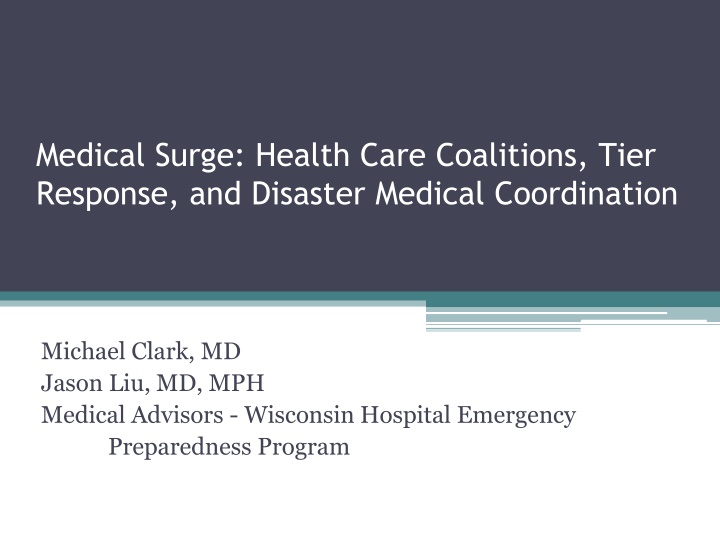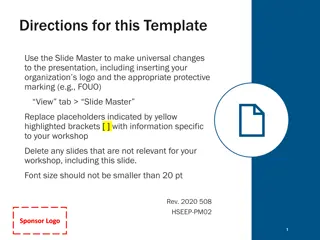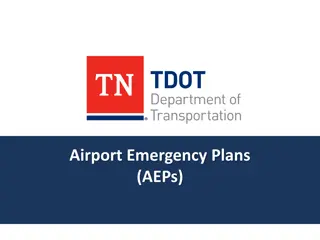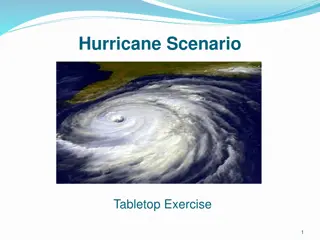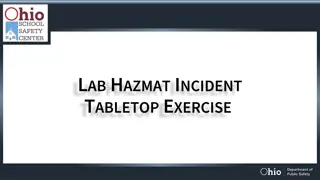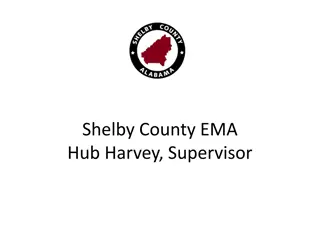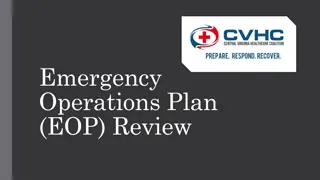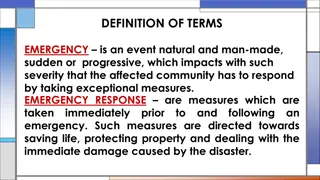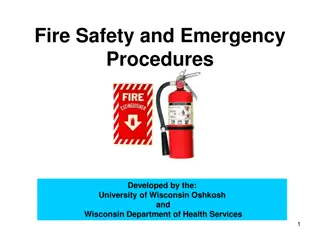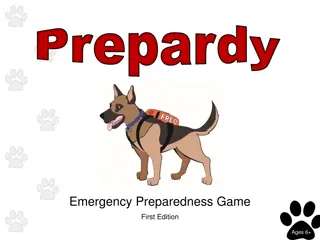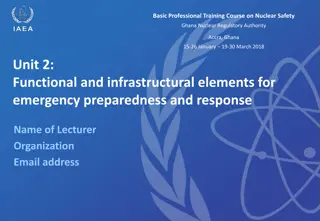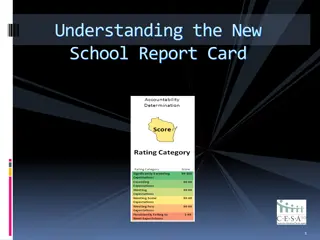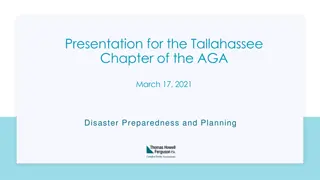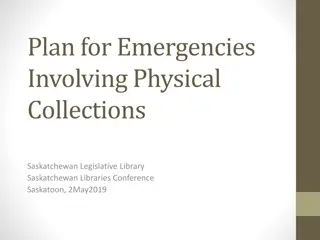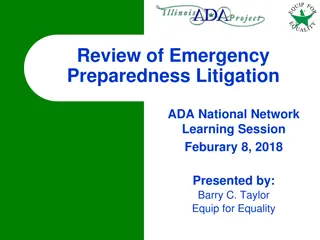Enhancing Healthcare Emergency Preparedness and Response in Wisconsin
The Wisconsin Hospital Emergency Preparedness Program (WHEPP) focuses on supporting hospitals in planning and responding to mass casualty incidents and pandemics. It emphasizes the importance of healthcare coalitions, tier coordination, and disaster medical coordination centers. The program, funded by ASPR, aims to strengthen regional response and recovery for the entire healthcare sector. Identified gaps in Wisconsin include coordinated health plans, regional medical coordination structures, crisis standards of care indicators, evacuation capabilities, patient tracking, medical surge, patient transport, health surveillance, resource mobilization, situational awareness, alerting, communication coordination, and bed availability.
Uploaded on Oct 05, 2024 | 4 Views
Download Presentation

Please find below an Image/Link to download the presentation.
The content on the website is provided AS IS for your information and personal use only. It may not be sold, licensed, or shared on other websites without obtaining consent from the author.If you encounter any issues during the download, it is possible that the publisher has removed the file from their server.
You are allowed to download the files provided on this website for personal or commercial use, subject to the condition that they are used lawfully. All files are the property of their respective owners.
The content on the website is provided AS IS for your information and personal use only. It may not be sold, licensed, or shared on other websites without obtaining consent from the author.
E N D
Presentation Transcript
Medical Surge: Health Care Coalitions, Tier Response, and Disaster Medical Coordination Michael Clark, MD Jason Liu, MD, MPH Medical Advisors - Wisconsin Hospital Emergency Preparedness Program
Outline WHEPP Background Healthcare Coalition Concept Tier Coordination and Disaster Medical Coordination Centers Role of Emergency Management
Wisconsin Hospital Emergency Preparedness Program Supports hospital emergency preparedness planning and response to mass casualty incidents or pandemic events Funded by the Office of the Assistant Secretary for Preparedness and Response (ASPR) in the U.S. Department of Health and Human Services. (DHHS)
Wisconsin Hospital Emergency Preparedness Program (WHEPP) Wisconsin Department of Health Services Division of Public Health Office of Preparedness and Emergency Health Care Preparedness Section WHEPP Public Health Preparedness Emergency Medical Services Section Trauma Section
Time of Transition Guidance from ASPR based on recent events (e.g. Joplin Tornado, Hurricane Sandy) now focuses on the development of Healthcare Coalitions Shift from funding specific agencies/entities to focusing on strengthening regional response and recovery using an Healthcare Coalitions Moving focus toward all of healthcare sector (and not just hospitals)
6 Wisconsin Gaps Coordinated health plans for large scale disasters Formal regional medical coordination structure Regional system for off-loading and on- loading patients in mass-casualty incidents Established indicators for crisis standards of care when resources are exhausted and systems are overwhelmed Evacuation and patient tracking capability
7 Health Emergency Priorities Improved system for medical surge Patient transport and evacuation plans in disasters Health surveillance and information sharing Ability to mobilize and coordinate medical resources Build situational awareness of medical resources Improve alerting and communication coordination Bed availability and patient tracking
Healthcare Coalitions (HCC) Group of healthcare organizations, emergency management, and public health partners that join forces for the common goal of making their communities safer, healthier and more resilient Support communities before, during and after disasters and other health-related crises Development is required by ASPR as condition of continued funding
HCC Purpose Coordinate how public health, healthcare institutions, emergency management and first responder agencies will manage their efforts to enact a uniform and unified response to an emergency, specifically the medical surge aspect of an event (ESF-8) Does not replace day-to-day functioning of individual agencies/organizations
Healthcare Coalitions in WI At state level, coordinated by Preparedness Section in DHS Regions have been defined by the Department of Health Services Regions are developing their own coalitions Initial discussions in-progress Goal is to have initial regional HCC s established with basic structure by July 1, 2015
11 Healthcare Coalition Partners Emergency Medical Services Hospitals and Clinics Trauma Emergency Management Public Health Long Term Care Mental and Behavioral Health Community and Faith Based Organizations Volunteer Organizations Businesses Human Services Medical Examiners and Coroners And many, many more!
Health Emergency Response Regions Seven Regions in state Determined at state level by DHS Based on previous WHEPP regions, which had been developed based on patient referral patterns Will be RTAC regions going forward Public Health and Emergency Management will participate and support region structure
13 Health Emergency Response Regions Bayfield Douglas Iron Ashland Vilas Washburn Florence Sawyer Burnett Oneida Price Forest Marinette Barron Rusk Polk Lincoln Langlade Taylor St. Croix Chippewa Menomonee Marathon Oconto Oconto Dunn Pierce Door Clark Shawano Eau Claire Pepin Kewaunee Waupaca Portage Buffalo Outagamie Trempealeau OutagamieBrown Wood Jackson Manitowoc Winnebago Waushara Adams Calumet Monroe La Crosse Green Lake Marquette Juneau Sheboygan Fond du Lac Vernon Dodge Sauk Washington Columbia Richland Crawford Ozaukee Dane Jefferson Waukesha Iowa Milwaukee Grant Racine Rock Green Walworth La Fayette Kenosha http://www.dhs.wisconsin.gov/preparedness/hospital/HERMapREV042314.pdf
14 Healthcare Coalitions Shift from funding specific agencies/entities for preparedness to focusing on strengthening a regional response and recovery system using an Healthcare Coalitions Healthcare coalitions represent a shift from WHAT we need to do to respond to HOW do we respond
15 Healthcare Coalitions Bring healthcare, public health and emergency management together with addition of other response partners to manage threats to the community Allows for important networking to develop the relationships to facilitate efficient responses Will serve to address current gaps and priorities
Key Components of HCC Regional Board of Directors* Regional HCC coordinator* Regional Trauma coordinator* HCC Medical Advisor* Medical Coordination Centers * Comprise the HCC Leadership Team
Regional Board of Directors Responsible for overall function of HCC Accountable to DHS, HCC state leadership, and HCC member organizations Exact size and membership at HCC discretion Composition should be representative of organizations, disciplines, and localities that form region and HCC Must include at least: One representative from a hospital/hospital system One representative from a public health department/organization One representative from an emergency management department/organization One representative from emergency medical services One representative from trauma
Tiered Coordination ASPR and WHEPP have developed a tier response concept Modular, bottom-up approach Consistent with Incident Command System principles Locally driven - each tier decides when to activate the next level Area or Regional Medical Coordinating Centers only assume coordination function when tier below requests it (or if tier below is obviously incapacitated)
Disaster Medical Coordination Purpose: Help to close critical gaps in medical surge capacity, continuity of operations, and enhance coordination Components include: Collection and collation of regional health information Situation awareness Monitoring of health care system performance and capacity Support to health care system logistic requests in coordination with state and local agencies
Disaster Medical Coordination Centers Designated healthcare or healthcare- related entity serving an area with the pre-determined ability to support the area or coalition as a whole Serve as the response arm of the healthcare coalition
Disaster Medical Coordination Centers Two levels of Disaster Medical Coordination Centers within HCC Area Medical Coordination Centers Located geographically in the area of an incident Likely multiple area centers within a region Regional Medical Coordination Center Designated entity serving a Health Emergency Region s coalition One per region
Regional Medical Coordination Centers Activities may include: Monitoring and alerting healthcare coalition partners in an emergency Coordination of: Information Hospital beds Patient Movement Providing situational awareness during a disaster to all response partners Providing clinical consultation and coordination
Area Medical Coordinating Center Regional Medical Coordinating Center Hospital X Local Hospital A Local Hospital B Hospital Y Local Hospital C Hospital Z Incident/ Incident Command Alternate Care Site 1 Alternate Care Site 2 = information flow = patient flow 23
RMCC Pilot Projects WHEPP is currently finding two pilots on RMCC development: Rural and Urban Medical Directors for each pilot serve as WHEPP Medical Advisors Rural: Michael Clark, MD - Ministry Health Care/Ministry St. Clare s Hospital/Ministry Spirit Medical Transportation Urban: Jason Liu, MD - Medical College of WI/Froedtert Hospital/Childrens Hospital of WI/Milwaukee County EMS
Objectives of Pilot Project Development and testing of policies/procedures for tiered disaster coordination Outline for a database of bed capacity and medical capabilities Disaster/special incident medical consultation expert panel Information collection/situational awareness indicators Alerting and notification processes Assistance/technical consultation to DHS and WHEPP in on-going preparedness projects Assistance/technical consultation to the Department of Health Services (DHS) and the Wisconsin Hospital Emergency Preparedness Program (WHEPP) Leadership as needed
26 How does HCC participation benefit Emergency Management? Gateway to ESF-8 partners involved in emergency/special incident Able to reach all receiving hospitals and other coalition partners more efficiently Facilitate communication on resources needed to support ESF-8 Allows Emergency Management to have information to better coordinate distribution and prioritization of resources Healthcare sector able to collectively work with government and private partners Provides enhanced resources Knowledge resources clinicians/providers, HCC Medical Advisor, regional experts, etc. Physical resources equipment, supplies, medications, bed space, etc.
27 How does HCC participation benefit Emergency Management? Streamlined information flow Surveillance/intelligence Treatment recommendations Situational awareness/updates Public and media information Translation of recommendations into treatment delivery Receive information and translate into care actions Ability to reach multi-disciplinary healthcare providers across region
Potential Roles of an Emergency Management in HCCs Planning Provide emergency management/regulatory perspective Assist with HCC area and regional plan development Participation in training/education and exercises Assist with distribution and adoption of planning Core knowledge of area/regional hazards Response Legal authorities in regards to response and declaration of emergency Personnel and equipment to support of HCC partners Scare resource access Established public communication and outreach tools
Potential Roles of an Emergency Management in HCCs Process Improvement Multi-agency after action review and process improvement support Outreach and Training
Additional Resources & Documents http://www.dhs.wisconsin.gov/preparedness/ho spital/
